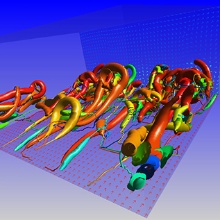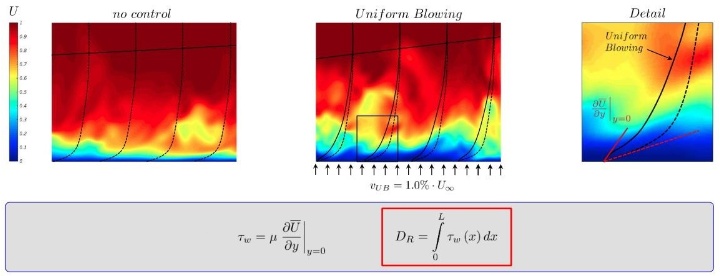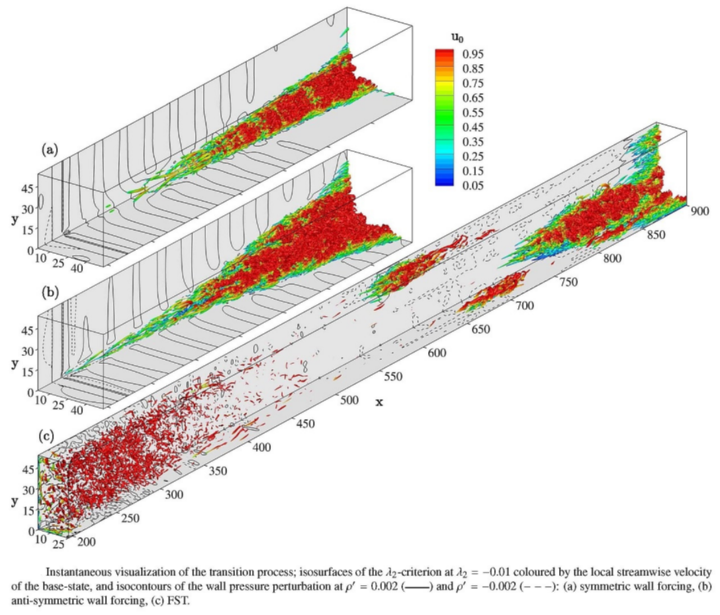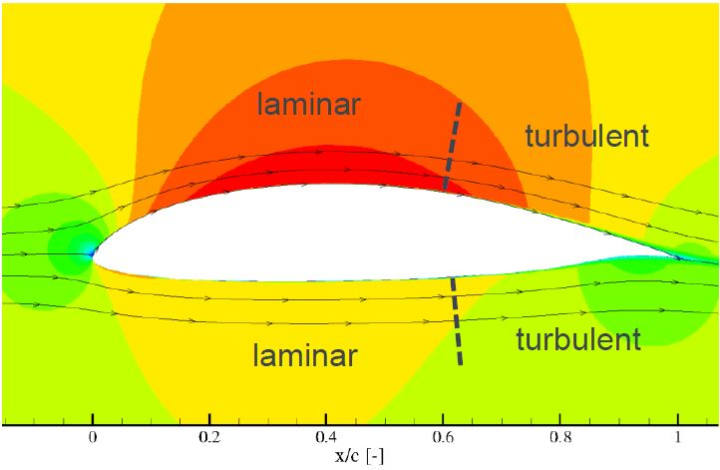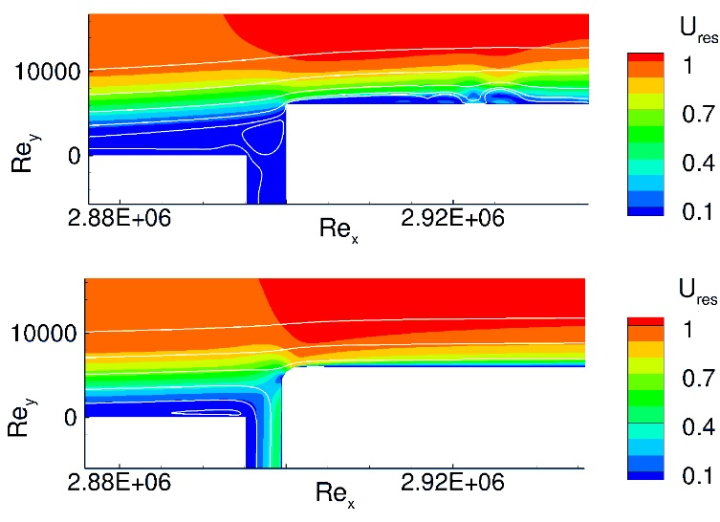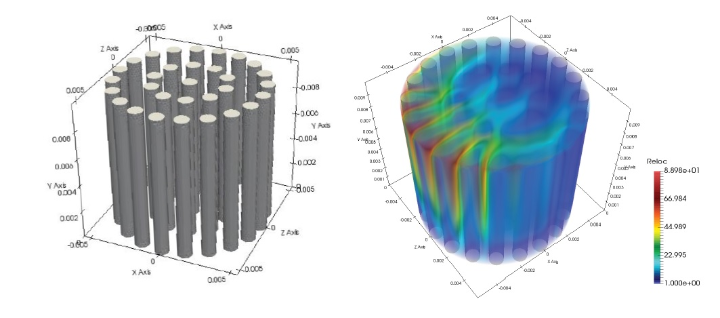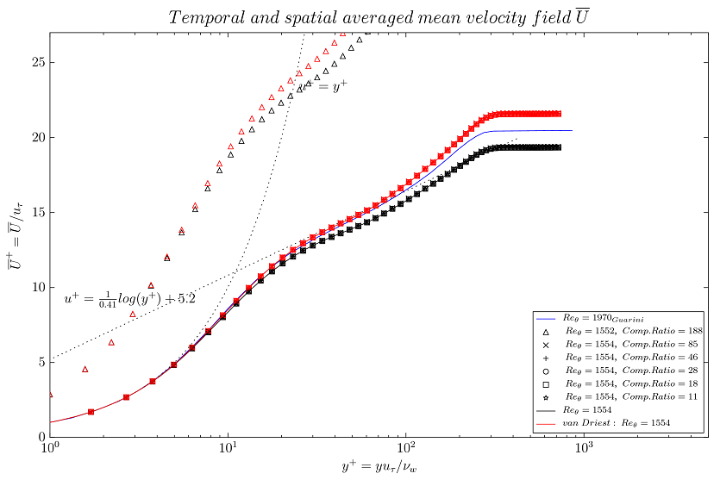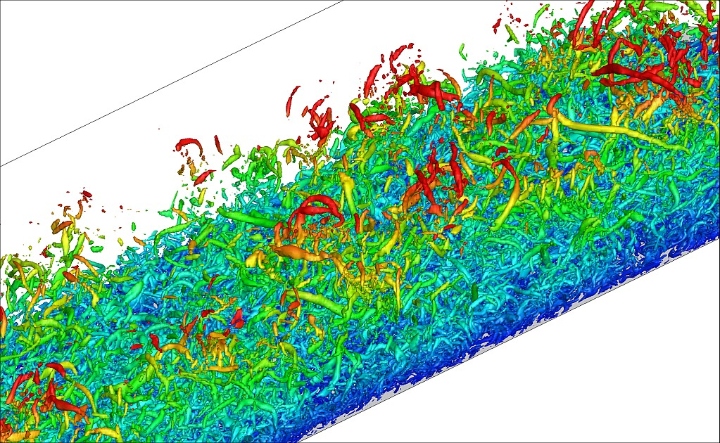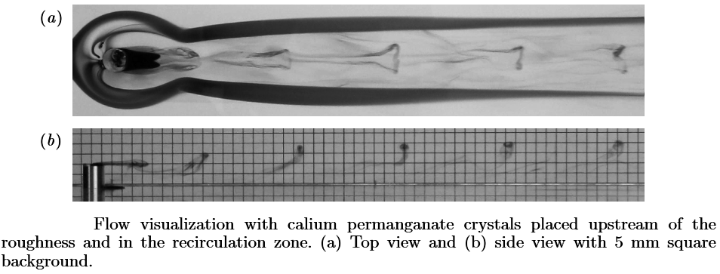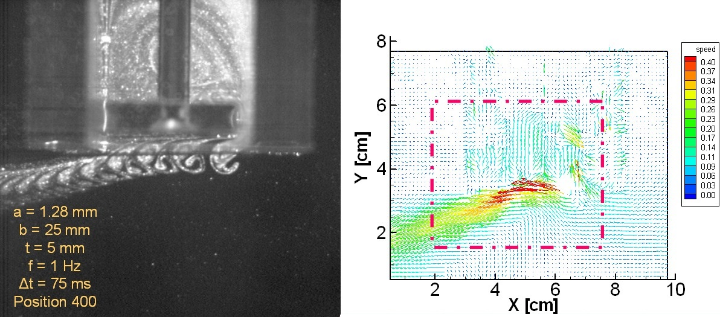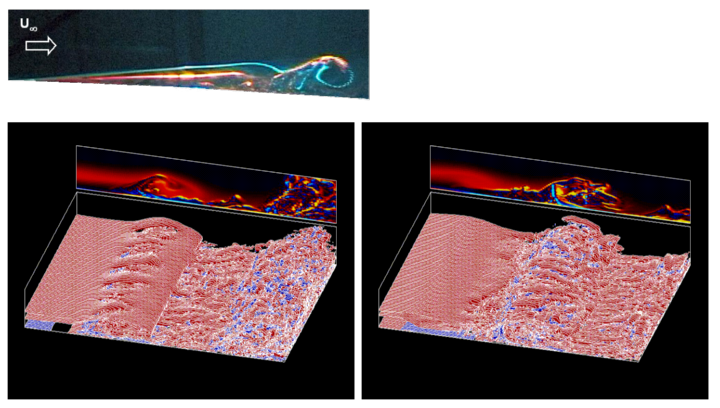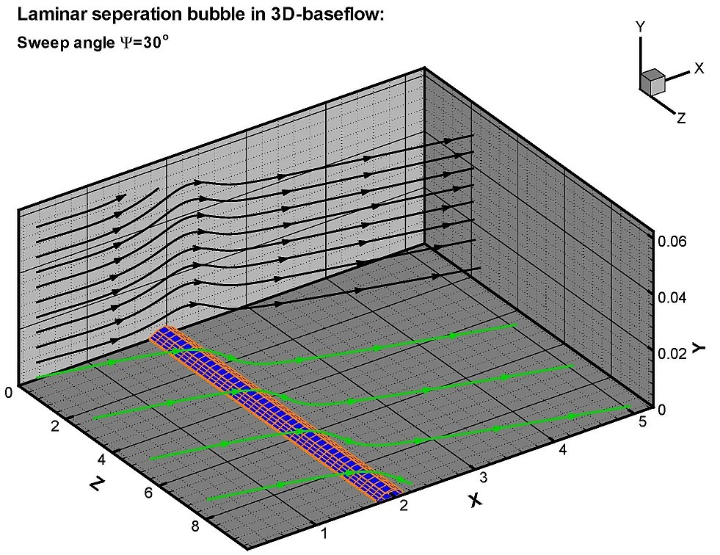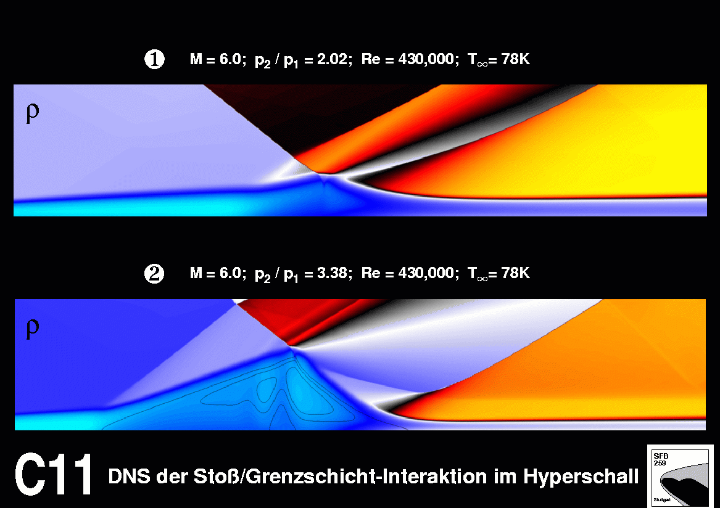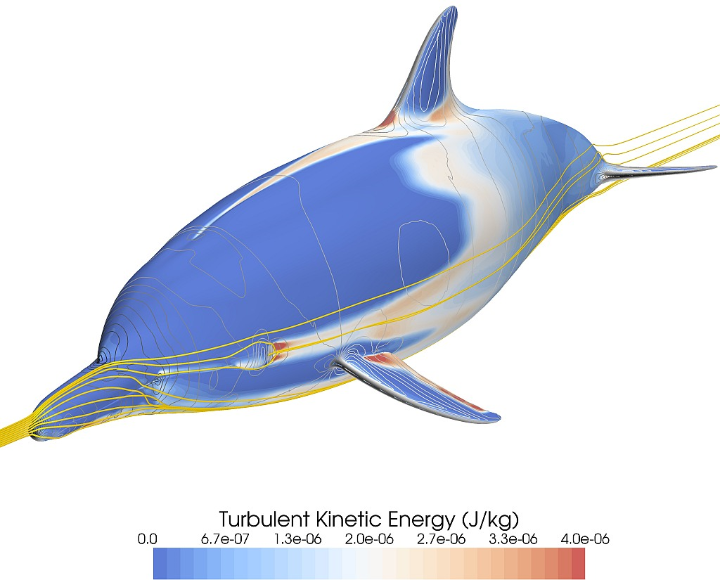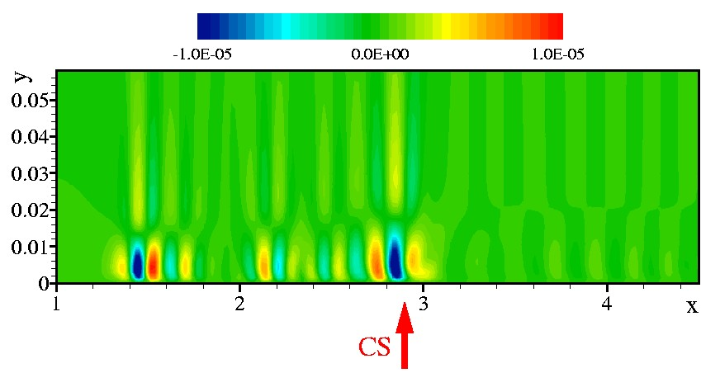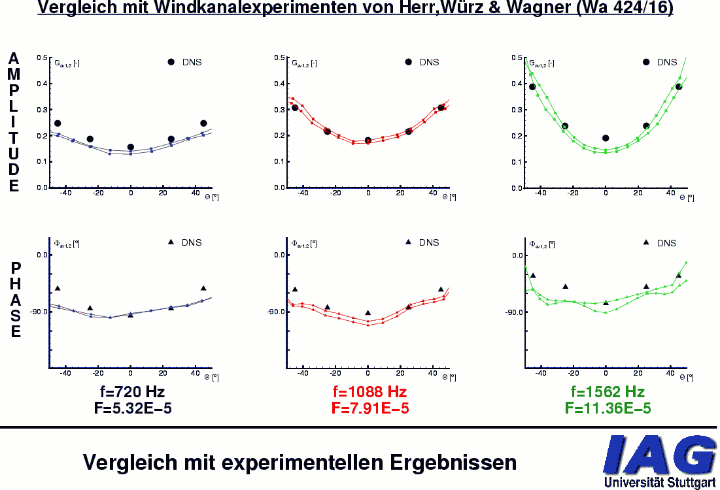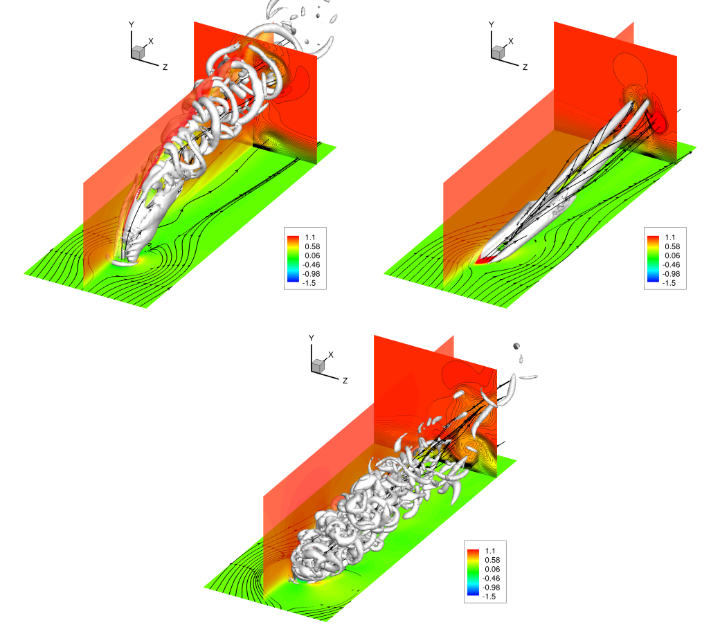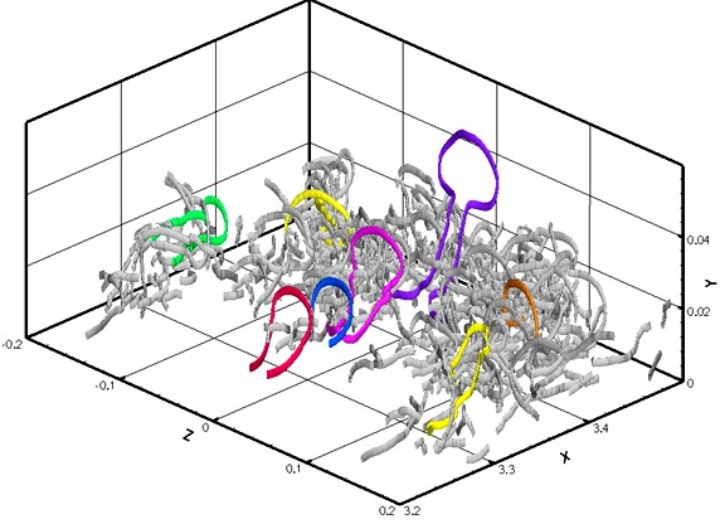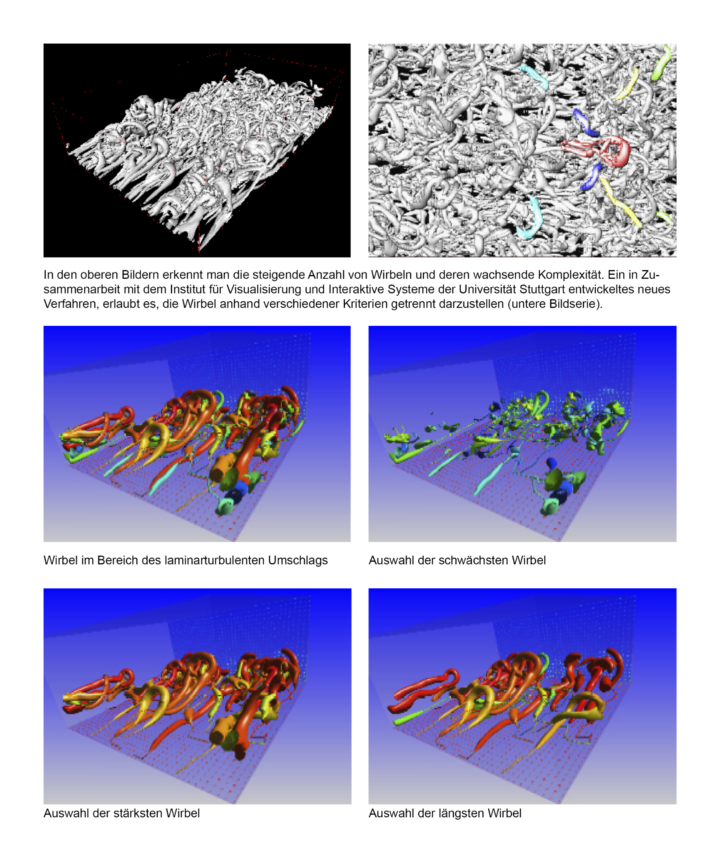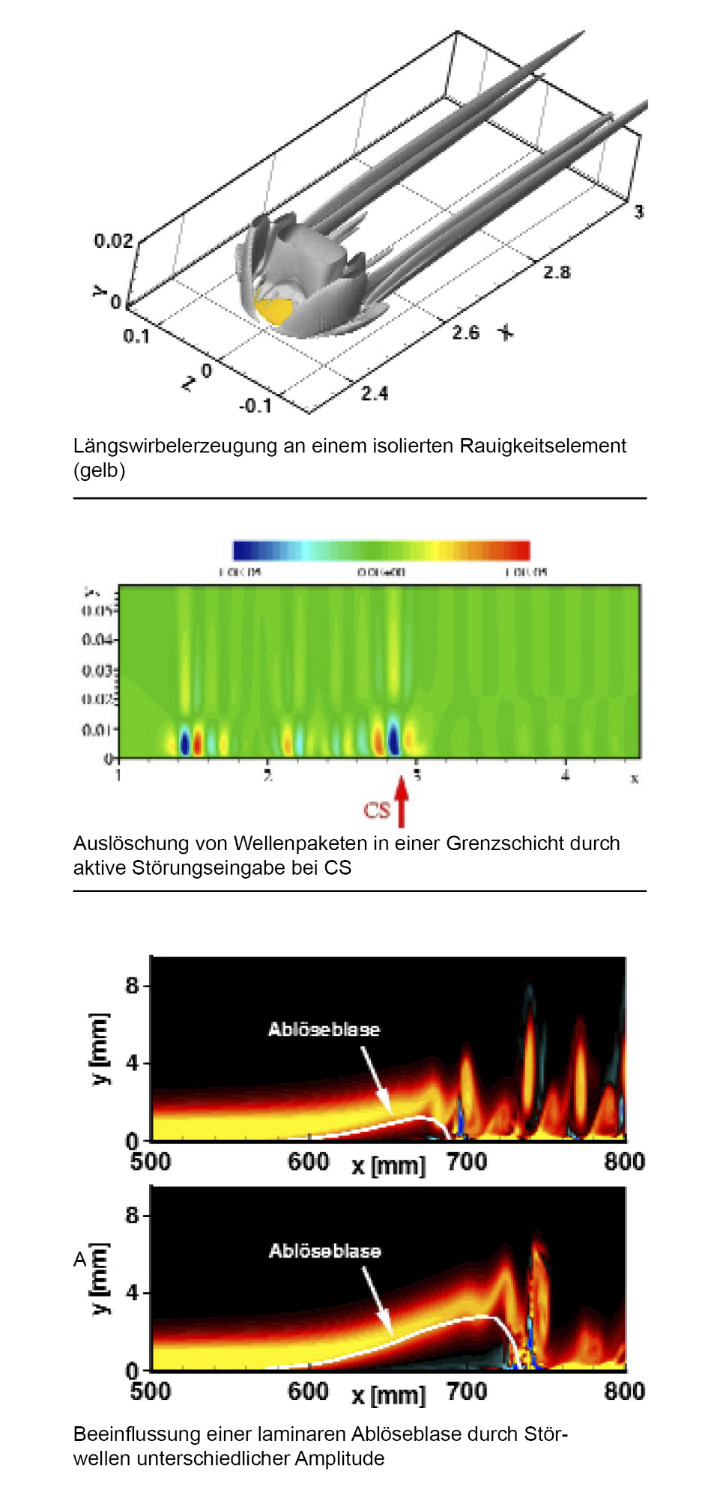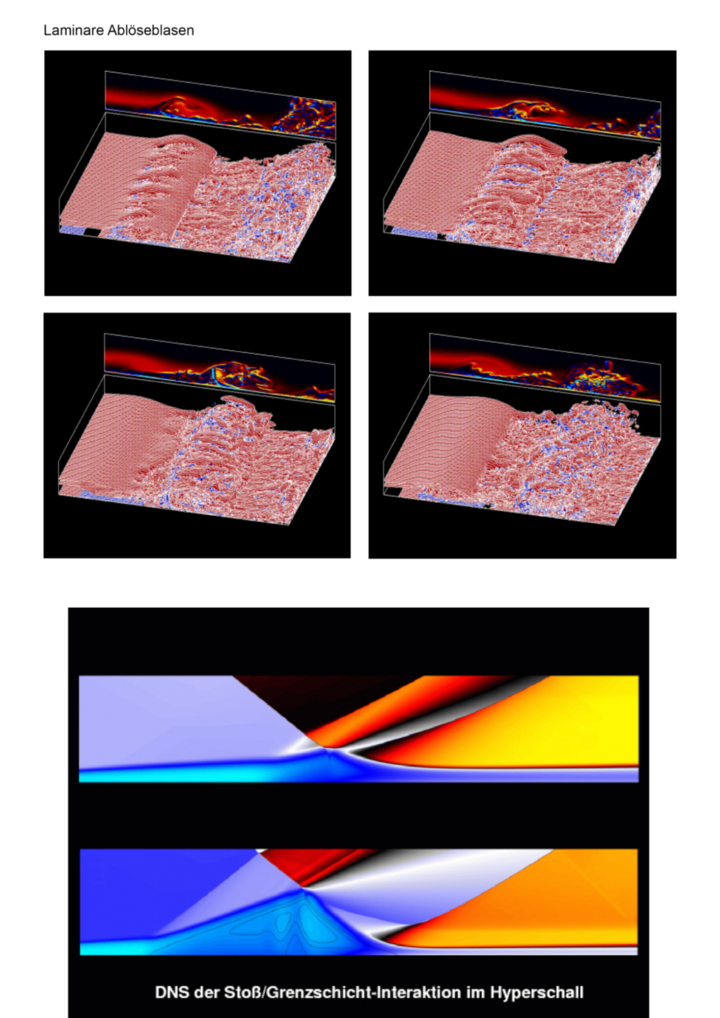Through so-called direct numerical simulation (DNS) and water channel experiments, flow instabilities, flow separation and turbulent wall boundary layers and their effects are investigated. The aim is to gain a profound understanding of these flows and their contribution to flow resistance in order to derive conclusions about actions to reduce resistance. As this inevitably involves large amounts of data, we are also concerned with their reduction, e.g. by modal analysis, compression and structure identification, as well as their appropriate visualization.
Research projects
The target of this investigation is drag reduction via continuous blowing through the wall in compressible boundary layers without and with adverse pressure gradients.
Further reading:
- C. Wenzel, U. Rist: Application of the von Kármán momentum theorem to turbulent boundary layers with uniform blowing, IAG Institutsbericht IB16-01
- Christoph Wenzel, Björn Selent, Ulrich Rist: DNS of compressible turbulent boundary layers at varying subsonic Mach numbers, 47th AIAA Fluid Dynamics Conference, 2017 AIAA Aviation and Aeronautics Forum and Exposition, June 2017
Instability and Control in Streamwise Corner Flow
When the boundary layers of two flat plates interact with each other in a 90-degrees angled corner, a streamwise corner boundary layer is formed. The purpose of this project is investigating all kinds of linear and non-linear instabilities which lead to laminar-turbulent transition in such a flow and to investigate means of controlling it.
Further reading:
F. Alizard, U. Rist, and J.-C. Robinet: "Linear Instability of Streamwise Corner Flow", in: B. Eckhardt (ed.), Advances in Turbulence XII, Springer Proceedings in Physics 132, 67-70, Springer-Verlag Berlin Heidelberg 2009
F. Alizard, J-C. Robinet, U. Rist: "Sensitivity to base-flow variation of a streamwise corner flow", in: P. Schlatter, D.S. Henningson (Eds.): Seventh IUTAM Symposium on Laminar-Turbulent Transition, IUTAM Bookseries 18, 2010, 69-74
F. Alizard, J.-C. Robinet, U. Rist: "Sensitivity analysis of a streamwise corner flow", Phys. Fluids 22 (1), 014103 (2010)
O. Schmidt, U. Rist: "Linear stability of compressible flow in a streamwise corner", J. Fluid Mech. (2011), vol. 688, pp. 569-590.
T. Schmidt, B. Selent, U. Rist: Direct numerical simulation of boundary layer transition in streamwise corner flow, in: W.E. Nagel, D. Kröner and M. Resch (Eds.): High Performance Computing in Science and Engineering '13, Springer, Berlin, Heidelberg, 2013, 337-348
O.T. Schmidt, U. Rist: Viscid-inviscid pseudo-resonance in streamwise corner-flow, J. Fluid Mech. 743 (2014), 327-357
O.T. Schmidt, U. Rist: Numerical investigation of classical and bypass transition in streamwise corner-flow, Proc. IUTAM ABCM Symposium on Laminar Turbulent Transition, Rio de Janeiro, 2014
O.T. Schmidt, S. Hosseini, A. Hanifi, D.S. Henningson, U. Rist: Optimal wave packets in streamwise corner-flow, Journal of Fluid Mechanics, J. Fluid Mech. 766 (2015), 405-435
O.T. Schmidt, J. Staudenmeyer, U. Rist, C.-D. Munz: Leading-edge receptivity to free-stream vorticity of streamwise corner-flow, in: New Results in Numerical and Experimental Fluid Mechanics X, Contribution to the 19th DGLR/STAB Symposium Munich, Germany, 2014, Springer-Verlag 2016, 259-268
J. Staudenmeyer, O. Schmidt, U. Rist: On the influence of Sommerfeld's radiation boundary condition on propagation direction of oblique modes in streamwise corner-flow, Journal of Fluid Mechanics 807, November 2016
Laminar-Turbulent Transition Under Unsteady Free-Stream Conditions
The purpose of this research is investigating the influences of unsteadiness on laminar-turbulent transition on an airfoil boundary layer encountered during passage of atmospheric turbulence. Low frequencies oscillations will lead to oscillations of the position of laminar-turbulent transition on the airfoil, cf. figure above. These oscillations shall be taken into account in direct numerical simulations and computations with linear stability theory. It will be investigated whether current (steady!) transition prediction tools are applicable or not.
Impact of Steps and Gaps on Laminar-Turbulent Transition
The purpose of this research is quantification of the detrimental impact of surface imperfections on laminar-turbulent transition in compressible boundary layers via local ΔN-factors extracted from direct numerical simulations (DNS). A novel feature is application of suction in front of a step for stabilization of the flow (cf. figure above).
Further reading:
- A. Wörner, U. Rist, S. Wagner: "Influence of humps and steps on the stability characteristics of a 2D laminar boundary layer", AIAA 2002-0139.
- A. Wörner, U. Rist, S. Wagner: "Humps/steps influence on stability characteristics of a 2D laminar boundary layer", AIAA Journal 41 (2) Feb. 2003, 192-197.
- C. Edelmann, U. Rist: Impact of forward-facing steps on laminar-turbulent transition in transonic flows without pressure gradient, AIAA 2013-0080, AIAA 51st Aerospace Sciences Meeting, 7-10 January 2013, Grapevine, Texas, USA 2013
- C. Edelmann, U. Rist: Impact of forward-facing steps on laminar-turbulent transition in transonic flows, AIAA Journal Vol. 53, No. 9, September 2015, 2504-2511
- J. Zahn, U. Rist: Impact of deep gaps on laminar-turbulent transition in compressible boundary layer flow, AIAA Journal 54(1):66-76, 2016
- C. Edelmann, U. Rist: On the Impact of Forward-Facing Steps on Disturbance Amplification in Boundary-Layer Flows, in: W.E. Nagel, D. Kröner and M. Resch (Eds.): High Performance Computing in Science and Engineering '15, Springer, Berlin, Heidelberg, 2016, 371-388.
- J. Zahn, U. Rist: Active and Natural Suction at Forward-Facing Steps for Delaying Laminar-Turbulent Transition, AIAA Journal 55(4):1343-1354, 2017
Micro-Pillars for Flow Sensing and Flow Control
This project started out from a cooperation with Prof. Brücker at TU Freiberg, now City University London. The initial purpose was numerical modeling of low-Reynolds number flow around so-called micro pillar sensors which are able to perform measurements of the instantaneous wall shear field in a boundary layer. Detailed comparisons with experiments have been performed. The new focus is now on using small, stiff pillars, i.e. bristles, in groups (cf. figure above) or patterns for flow control in laminar and turbulent boundary layers.
Further reading:
- F. Hegner, V. Mikulich, G. Axtmann, U. Rist, Ch. Brücker: Extreme event detection in near-wall turbulence using reflection-encoded readout of micropillar arrays, Proceedings in Applied Mathematics and Mechanics, 28 May 2015
- G. Axtmann, U. Rist, F, Hegner, C. Brücker: Numerical investigation of the bending of slender wall-mounted cylinders in low Reynolds number flow, in: New Results in Numerical and Experimental Fluid Mechanics X, Contribution to the 19th DGLR/STAB Symposium Munich, Germany, 2014, Springer-Verlag 2016, 191-201
- G. Axtmann, F. Hegner, C. Brücker, U. Rist: Investigation and Prediction of the Bending of Single and Tandem Pillars in a Laminar Cross Flow, Journal of Fluids and Structures 66, July 2016
As the performance of supercomputers steadily increases approximately according to “Amdahl's law”, mostly due to massive parallelization of computations, data input/output (I/O) won’t be able to compete with data production on future Exascale-Computers. As part of the EC framework 6 ExaFLOW project we perform research on data I/O parallelization and data compression.
Further reading:
- H. Gunes, U. Rist: "On the use of kriging for enhanced data reconstruction in a separated transitional flat-plate boundary layer", Physics of Fluids 20 (10): online 31 October 2008.
- H. Gunes, H.E. Cekli, U. Rist: "Data enhancement, smoothing, reconstruction and optimization by Kriging interpolation", S.J. Mason, R.R. Hill, L. Mönch, O. Rose, T. Jefferson, J.W. Fowler (Eds.): Proceedings of the 2008 Winter Simulation Conference, Miami, Dec. 2008.
- Patrick Vogler and Ulrich Rist: Wavelet Based Compression of Volumetric CFD Data Sets, Proceedings of the Joint Workshop on Sustained Simulation Performance, University of Stuttgart (HLRS) Dec. 2016 and Tohoku University, 2017
Turbulent Superstructures in a Flat-Plate Boundary Layer
One purpose of this research is detection of organized super-structures, also termed Very-Large-Scale Motions (VLSM) in literature using up-to-date structure identification techniques. Another aim is trying to find their origins, either via tracking in time or recent developments in multi-dimensional linear stability theory.
Further reading:
- V.I. Borodulin, V.R. Gaponenko, Y.S. Kachanov, D.G.W. Meyer, U. Rist, Q.X. Lian, C.B. Lee: "Late-stage transitional boundary-layer structures. Direct numerical simulation and experiment", Theoret. Comput. Fluid Dynamics 15 (2002) 5, 317 - 337.
- D. Meyer, U. Rist, S. Wagner: "Direct numerical simulation of the development of asymmetric perturbations at very late stages of the transition process". In: S. Wagner, M. Kloker, U. Rist (Eds.): Recent Results in Laminar-Turbulent Transition – Selected Numerical and Experimental Contributions from the DFG-Verbundschwerpunktprogramm "Transition" in Germany, NNFM Vol. 86, Springer, Heidelberg, 2003, 63-74.
- D. Meyer, U. Rist, M. Kloker: "Investigation of the flow randomization process in a transitional boundary layer." In: E. Krause, W. Jäger and M. Resch (Eds.): High Performance Computing in Science and Engineering '03, Springer, Berlin, Heidelberg, 2003, 239-254.
- Christoph Wenzel, Björn Selent, Ulrich Rist: DNS of compressible turbulent boundary layers at varying subsonic Mach numbers, 47th AIAA Fluid Dynamics Conference, 2017 AIAA Aviation and Aeronautics Forum and Exposition, June 2017
Influence of Isolated Roughness Elements on Laminar-Turbulent Transition
This experimental work is based on very detailed investigations of instability mechanisms occurring in the streaks behind cylindrical roughness elements in a laminar boundary layer for comparison with the latest developments in multi-dimensional linear stability theory. Instability-mode structures, growth rates and the occurrence of global instability when the roughness Reynolds number is increased are to be compared with theory.
Further reading:
- A. Wörner, U. Rist, S. Wagner: "Investigation of the Flow in the Vicinity of an Isolated 3D Surface Roughness". In: C. Breitsamter, B. Laschka, H.J. Heinemann, R. Hilbig (Eds.): New Results in Numerical and Experimental Fluid Mechanics IV, Contributions to the 13th STAB/DGLR Symposium, Munich, Germany 2002, NNFM 87, Springer-Verlag, 2004, 319 - 326.
- U. Rist, A. Jäger: "Unsteady disturbance generation and amplification in the boundary-layer flow behind a medium-sized roughness element", in: R. Govindarajan (Ed.): Sixth IUTAM Symposium on Laminar-Turbulent Transition, Proc. IUTAM-Symp. Bangalore, India, 2004, Fluid Mechanics and its Applications, Vol. 78, Springer-Verlag, 293-298, 2006.
- E. Piot, G. Casalis, U. Rist: "Stability of the laminar boundary layer flow encountering a row of roughness elements: Biglobal stability approach and DNS", European Journal of Mechanics B/Fluids 27 (6), 2008, 684-706.
- Y-S. Shin, U. Rist, E. Krämer: Stability of the laminar boundary-layer flow behind a roughness element, Exp. Fluids (2015) 56:11, DOI 10.1007/s00348-014-1878-2
- J. Ost, E- Mäteling, C. Klein, D. Puckert, U. Rist: Reattaching flow behind a square bump investigated with temperature sensitive paint, STAB-Symposium, Braunschweig, November 8-9, 2016. To appear in Notes on Numerical Fluid Mechanics 2017
- D. Puckert, U. Rist: Transition downstream of an isolated cylindrical roughness element on a flat plate boundary layer, STAB-Symposium, Braunschweig, November 8-9, 2016. To appear in Notes on Numerical Fluid Mechanics 2017
- Dominik Puckert, Michael Dieterle, Ulrich Rist: Reduction of freestream turbulence at low velocities, accepted for publication in Experiments in Fluids, March 2017
Jet-and-Vortex Actuator (JaVA)
The JaVA is a unique zero-net-mass-flux actuator that consists of a cantilever beam oscillating at the top of an immersed cavity with gaps of different width for the actuator-induced flow. Depending on the actuation parameters (Reynolds and Strouhal number) different flow patterns can be obtained in the surrounding space.
Further reading:
- H. Gunes, S. Cadirci, U. Rist: "An Experimental Investigation of a Jet and Vortex Actuator for Active Flow Control", AIAA 2008-3761, 4th AIAA Flow Control Conference 23-26 June 2008, Seattle, WA.
- H. Gunes, S. Cadirci, F. Baldani, B. Peters, U. Rist: "Temporal analysis of jet and vortex actuator (JaVA) - induced flows", Proc. Int. Conf. on Jets, Wakes and Separated Flows, ICJWSF-2008, September 16-19, 2008, Technical University of Berlin, Berlin, Germany
- M.A. Rashad, U. Rist: "Numerical investigation of a jet and vortex actuator (JaVA)", in: A. Dillmann, G. Heller, M. Klaas, H.P. Kreplin, W. Nitsche, W. Schröder (Eds.): New Results in Numerical and Experimental Fluid Dynamics VII. NNFM 112 Contributions to the 16. STAB/DGLR-Symposium, Aachen, Nov. 2008, Springer, 2010, 217-224.
- S. Cadirci, H. Gunes, U. Rist, B. Peters: "Experimental Investigation of Jet and Vortex Actuator Using Particle Image Velocimetry", IMECE2009-11451, ASME International Mechanical Engineering Congress & Exposition IMECE2009, Nov. 13-19, 2009, Lake Buena, FL, USA.
- S. Cadirci, H. Gunes, U. Rist: "Numerical Investigation of Jet and Vortex Actuator (JaVA) for Active Flow Control", AIAA-2010-4410, 5th Flow Control Conference, Chicago, IL, 28 Jun - 1 Jul 2010.
- A. Rashad, U. Rist: "Numerical Investigation of a Jet-and-Vortex-Actuator Without and With Cross-Flow Boundary Layer", Int. J. Heat Fluid Flow 33 (2012) 35-44, doi:10.1016/j.ijheatfluidflow.2011.10.005
- S. Cadirci, H. Gunes, U. Rist: Active flow control applications with a jet and vortex actuator in a laminar cross flow, International Journal of Heat and Fluid Flow, Volume 39, February 2013, 146-159
- S. Cadirci, H. Gunes, U. Rist: Numerical investigation of a jet and vortex actuator in a cross-flow boundary-layer, European Journal of Mechanics - B/Fluids, Vol. 44 (2013), pp. 42-59
Laminar-Turbulent Transition in Laminar Separation Bubbles
Laminar separation bubbles occur when a laminar boundary layer separates, undergoes laminar-turbulent transition, and re-attaches as a turbulent boundary layer. An increased linear stability occurs already upstream of laminar separation which leads to rapid growth of small disturbances. Non-linear and feed-back effects may occur as well and influence the laminar-turbulent transition process. Experiments and computer simulations have been performed to study these problems.
Further reading:
- M. Lang, O. Marxen, U. Rist, S. Wagner, W. Würz: "LDA-Messungen zur Transition in einer laminaren Ablöseblase", Proc. 8. Fachtagung GALA, Freising, 12. - 14.9.2000.
- M. Lang, O. Marxen, U. Rist, S. Wagner: "Experimental and numerical investigations on transition in a laminar separation bubble", in: S. Wagner, U. Rist, H.J. Heinemann, R. Hilbig (Eds.): New Results in Numerical and Experimental Fluid Mechanics III, Proc. 12. DGLR-Fachsymposium AG STAB, Stuttgart, 15.-17.11.2000, NNFM Vol. 77, Springer-Verlag, 2002, 207 - 214.
- U. Rist, U. Maucher: "Investigations of Time-Growing Instabilities in Laminar Separation Bubbles", European Journal of Mechanics B/Fluids 21 (2002), 495-509.
- O. Marxen, M. Lang, U. Rist, S. Wagner: "A combined experimental/numerical study of unsteady phenomena in a laminar separation bubble". Journal of Flow, Turbulence and Combustion 71, 2003, 133-146.
- M. Lang, O. Marxen, U. Rist, S. Wagner: "A combined numerical and experimental investigation of transition in a laminar separation bubble". In: S. Wagner, M. Kloker, U. Rist (Eds.): Recent Results in Laminar-Turbulent Transition – Selected Numerical and Experimental Contributions from the DFG-Verbundschwerpunktprogramm "Transition" in Germany, NNFM Vol. 86, Springer, Heidelberg, 2003, 149-165.
- O. Marxen, U. Rist: "DNS and LES of the transition process in a laminar separation bubble". In: R. Friedrich, B.J. Geurts, O. Metais (Eds.), Direct and Large-Eddy Simulation V, Proc. 5th internat. ERCOFTAC workshop, Munich, August 27-29, 2003, Kluwer Academic Publishers, Dordrecht, Boston, London (2004), 231-240
- U. Rist: "Instability and Transition Mechanisms in Laminar Separation Bubbles". VKI/RTO-LS "Low Reynolds Number Aerodynamics on Aircraft Including Applications in Emerging UAV Technology", Rhode-Saint-Genese, Belgium, 24-28 November 2003
- O. Marxen, U. Rist, S. Wagner: "The effect of spanwise-modulated disturbances on transition in a 2-D separated boundary layer", AIAA 2003-0789, Jan. 2003. AIAA Journal 42 (5) May 2004, 937-944.
- O. Marxen, U. Rist, D. Henningson: "Steady three-dimensional streaks and their optimal growth in a laminar separation bubble", in: H.J. Rath, C. Holze, H.J. Heinemann, R. Henke, H. Hönlinger (Eds.): " New Results in Numerical and Experimental Fluid Mechanics V", Proc. 14. DGLR-Fachsymposium AG STAB, Bremen, Germany 2004, NNFM 92, 233-240, Springer-Verlag, 2006.
- O. Marxen, U. Rist: "Direct Numerical Simulation of Non-Linear Transitional Stages in an Experimentally Investigated Laminar Separation Bubble", in: W. Nagel, W. Jäger and M. Resch (Eds.): High Performance Computing in Science and Engineering '05, Springer, Berlin, Heidelberg, 2005, pp. 103-117.
- O. Marxen, M. Lang, U. Rist, O. Levin, D. Henningson: "Mechanisms for Spatial Steady Three-Dimensional Disturbance Growth in a Non-Parallel and Separating Boundary Layer", Journal of Fluid Mechanics (2009), vol. 634, pp. 165-189.
- O. Marxen, U. Rist: "Mean Flow Deformation in a Laminar Separation Bubble: Separation and Stability Characteristics", Journal of Fluid Mechanics (2010), vol. 660, pp. 37-54.
- A. Probst, R. Radespiel, U. Rist: "Linear-stability-based transition modeling for aerodynamic flow simulations with a near-wall Reynolds-stress model", AIAA Journal, 2011, vol. 50, no. 2, 416-428.
- O. Marxen, O., Lang, M., Rist, U.: Discrete linear local eigenmodes in a separating laminar boundary layer, Journal of Fluid Mechanics Volume 711, November 2012, pp 1 - 26 doi: 10.1017/jfm.2012.263 Published Online on 27th September 2012.
- O. Marxen, O., Lang, M., Rist, U.: Vortex formation and vortex breakup in a laminar separation bubble, Journal of Fluid Mechanics (2013), vol. 728, pp. 58-90
Swept Laminar Separation Bubbles
Adding a constant spanwise cross flow to a two-dimensional laminar separation bubble cause a swept flow, see figure above. Structure and linear stability of this flow has been investigated by various means for different sweep angles.
Further reading:
- T. Hetsch, U. Rist: "On the structure and stability of three-dimensional laminar separation bubbles on a swept plate".
- In: C. Breitsamter, B. Laschka, H.J. Heinemann, R. Hilbig (Eds.): New Results in Numerical and Experimental Fluid Mechanics IV, Contributions to the 13th STAB/DGLR Symposium, Munich, Germany 2002, NNFM 87, Springer-Verlag, 2004, 302 - 310.
- T. Hetsch, U. Rist: "Direct Numerical Simulation and Analysis of the Flow Field Around a Swept Laminar Separation Bubble", in: W. Nagel, W. Jäger and M. Resch (Eds.): High Performance Computing in Science and Engineering '06, Springer, Berlin, Heidelberg, 2007, 205-221.
- T. Hetsch, U. Rist: "On the accuracy of local and nonlocal linear stability theory in swept laminar separation bubbles", AIAA Journal 2009, vol. 47, no. 5, pp. 1116-1122
- T. Hetsch, U. Rist: "An analysis of the structure of laminar separation bubbles in swept infinite geometries", European Journal of Mechanics -- B/Fluids 28 (4), 2009, 486-493.
- T. Hetsch, U. Rist: "The influence of sweep on the linear stability of a series of swept laminar separation bubbles", European Journal of Mechanics -- B/Fluids 28 (4), 2009, 494-505
- T. Hetsch, U. Rist: "Interaction of separation and transition in laminar separation bubbles in a 3D boundary layer". RTO Specialists’ Meeting on "Enhancement of NATO Military Flight Vehicle Performance by Management of Interacting Boundary Layer Transition and Separation", Prague, Cz, 4-8 October 2004, Paper No. 10.
- T. Hetsch, U. Rist: "Applicability and quality of linear stability theory and linear PSE in swept laminar separation bubbles", in: H.J. Rath, C. Holze, H.J. Heinemann, R. Henke, H. Hönlinger (Eds.): "New Results in Numerical and Experimental Fluid Mechanics V", Proc. 14. DGLR-Fachsymposium AG STAB, Bremen, Germany 2004, NNFM 92, 241-248, Springer-Verlag, 2006.
- T. Hetsch, U. Rist: "The effect of sweep on laminar separation bubbles", in: R. Govindarajan (Ed.): Sixth IUTAM Symposium on Laminar-Turbulent Transition, Proc. IUTAM-Symp. Bangalore, India, 2004, Fluid Mechanics and its Applications, Vol. 78, Springer-Verlag, 395-400, 2006.
Shock/Boundary Layer Interaction
In supersonic flows laminar separation bubbles may occur when an oblique shock hits a laminar boundary layer or when the wall suddenly bends to form a compression ramp.
Further reading:
- A. Pagella, U. Rist, S. Wagner: "Numerical investigations of small-amplitude disturbances in a laminar boundary layer with impinging shock waves", in: S. Wagner, U. Rist, H.J. Heinemann, R. Hilbig (Eds.): New Results in Numerical and Experimental Fluid Mechanics III, Proc. 12. DGLR-Fachsymposium AG STAB, Stuttgart, 15.-17.11.2000, NNFM Vol. 77, Springer-Verlag, 2002, 153 - 160.
- A. Pagella, U. Rist, S. Wagner: "Numerical investigations of small-amplitude disturbances in a boundary layer with impinging shock wave at Ma=4.8", Physics of Fluids 14, July 2002, 2088 - 2101.
- A.Pagella, U. Rist, S. Wagner: "Numerical Investigations of Transitional Flat-Plate Boundary Layers with Impinging Shock Waves". In: D.E. Zeitoun, J. Periaux, J.A. Desideri, M. Marini (eds.): Proc. W.E.H.S.F.F. Conference, Marseille, France, April 22-26, 2002, CIMNE (Barcelona, Spain), pp. 377 - 384.
- Pagella, A. Babucke, U. Rist: "Numerical investigations of small-amplitude disturbances in a boundary layer at Ma=4.8: compression corner vs. impinging shock wave". Physics of Fluids, 16 (7) July 2004, 2272-2281.
- A. Pagella, U. Rist (2004): "Instability and transition in shock-induced separation bubbles". RTO Specialists’ Meeting on "Enhancement of NATO Military Flight Vehicle Performance by Management of Interacting Boundary Layer Transition and Separation", Prague, Cz, 4-8 October 2004, Paper No. 23.
- A. Pagella, U. Rist: "Direct numerical simulations of shock-boundary layer interaction at Ma=6". In: E. Krause, Y.I. Shokin, M. Resch, N. Shokina (Eds.): "Computational Science and High Performance Computing", Russian-German Advanced Research Workshop, Novosibirsk, Russia, Sept. 30 - Oct. 2, 2003, NNFM 88, Springer-Verlag, 2005, pp. 123-140.
Flexible Wall
Inspired by the hypothesis that flexible walls delay laminar-turbulent transition we performed investigations on the influence of a flexible wall on linear instability. We also tried to estimate the transition location on a dolphin using CFD (see figure above).
Further reading:
- M. Zengl, U. Rist: "Linear stability investigations of flow over yawed anisotropic compliant walls", in: P. Schlatter, D.S. Henningson (Eds.): Seventh IUTAM Symposium on Laminar-Turbulent Transition, IUTAM Bookseries 18, 2010, 601-604
- M. Zengl, U. Rist: "Receptivity considerations for cascaded actuators generating Tollmien-Schlichting waves", in: A. Dillmann, G. Heller, M. Klaas, H.P. Kreplin, W. Nitsche, W. Schröder (Eds.): New Results in Numerical and Experimental Fluid Dynamics VII. NNFM 112 Contributions to the 16. STAB/DGLR-Symposium, Aachen, Nov. 2008, Springer, 2010, 281-288.
- R. Losse, R. King, M. Zengl, U. Rist, B.R. Noack: "Control of Tollmien-Schlichting instabilities by finite distributed wall actuation", Theoret. Comput. Fluid Dynamics, 25 (2011), 167-178.
- D. Riedeberger, U. Rist: "Numerical simulation of laminar-turbulent transition on a dolphin using the γ-Re_θ model", in: W.E. Nagel, D. Kröner and M. Resch (Eds.): High Performance Computing in Science and Engineering '11, Springer, Berlin, Heidelberg, 2012
- M. Zengl, U. Rist: "Linear-stability investigations for flow-control experiments related to flow over compliant walls", in: Cameron Tropea and Horst Bleckmann (Eds.) Nature-Inspired Fluid Mechanics. Results of the DFG Priority Programme 1207 2006-2012, NNFM 119, Springer, 2012, 223-237.
- V. Pavlov, D. Riedeberger, U. Rist, U. Siebert: "Analysis of the relation between skin morphology and local flow conditions for a fast-swimming dolphin", in: Cameron Tropea and Horst Bleckmann (Eds.) Nature-Inspired Fluid Mechanics. Results of the DFG Priority Programme 1207 2006-2012, NNFM 119, Springer, 2012, 239-253.
ωz-Control
Here we investigated using a control strip (CS in above figure) where wall-normal suction and blowing is derived from instantaneous wall shear ωz. This leads to an effective reduction of boundary layer disturbances in the linear and in the non-linear regime.
Further reading:
- C. Gmelin, U. Rist, S. Wagner: "Active control of nonlinear disturbances in 2-D boundary layers", in: P. Thiede (Ed.), Aerodynamic Drag Reduction Technologies, Proc. CEAS/DragNet Conference, Potsdam, 19.-21.6.2000, NNFM Vol. 76, Springer-Verlag, Berlin, Heidelberg 2001, 333-340.
- C. Gmelin, U. Rist, S. Wagner: "Active control of laminar-turbulent transition using instantaneous vorticity signals at the wall", Physics of Fluids 13 (2), Feb. 2001, 513 - 519.
- Gmelin, U. Rist, S. Wagner: "DNS of active control of disturbances in a Blasius boundary layer", in: E. Krause and W. Jäger (Eds.): High Performance Computing in Science and Engineering '01, Springer, Berlin, 2002, 273-285.
- C. Gmelin, U. Rist, S. Wagner: "Numerical investigations of active control of boundary-layer instabilities". In: S. Wagner, M. Kloker, U. Rist (Eds.): Recent Results in Laminar-Turbulent Transition – Selected Numerical and Experimental Contributions from the DFG-Verbundschwerpunktprogramm "Transition" in Germany, NNFM Vol. 86, Springer, Heidelberg, 2003, 203-218.
- H. Gunes, U. Rist: "Proper orthogonal decomposition reconstruction of a transitional boundary layer with and without control". Physics of Fluids, 16 (8) Aug. 2004, 2763-2784.
Boundary Layer Receptivity
The interaction of free-stream sound with wall roughness determines the initial amplitudes of Tollmien-Schlichting waves in a laminar boundary layer. This problem was investigated numerically and compared to wind tunnel experiments.
Further reading:
- A. Wörner, U. Rist, S. Herr, W. Würz, S. Wagner, Y.S. Kachanov: "Study of the acoustic receptivity of a Blasius boundary layer in the presence of a surface non-uniformity", Proc. ECCOMAS 2000, Barcelona 11. - 14.9.2000.
- S. Herr, A. Wörner, W. Würz, U. Rist, S. Wagner: "Experimental/numerical investigation of the influence of a pressure gradient on acoustic roughness receptivity in the boundary layer of an airfoil", in: S. Wagner, U. Rist, H.J. Heinemann, R. Hilbig (Eds.): New Results in Numerical and Experimental Fluid Mechanics III, Proc. 12. DGLR-Fachsymposium AG STAB, Stuttgart, 15.-17.11.2000, NNFM Vol. 77, Springer-Verlag, 2002, 231 - 238.
- W. Würz, S. Herr, A. Wörner, U. Rist, S. Wagner, Y.S. Kachanov: "Three-dimensional roughness-acoustic receptivity of a boundary layer on an airfoil. Experiment and DNS." J. Fluid Mech. 478, 2003, 135-163.
- S. Herr, W. Würz, A. Wörner, U. Rist, S. Wagner, A. Ivanov, Y. Kachanov: "Systematic investigations of 3D acoustic receptivity with respect to steady and unsteady disturbances. Experiment and DNS.". In: S. Wagner, M. Kloker, U. Rist (Eds.): Recent Results in Laminar-Turbulent Transition – Selected Numerical and Experimental Contributions from the DFG-Verbundschwerpunktprogramm "Transition" in Germany, NNFM Vol. 86, Springer, Heidelberg, 2003, 75-90.
Jet-in-Crossflow (JiC)
The Jet-in-Crossflow problem is a generic configuration for fluid injection in combustion and for boundary layer control. The effects of various blowing amplitudes and directions (both, azimuth and yaw) are investigated by direct numerical simulations and linear stability theory.
Further reading:
- B. Selent, U. Rist: "Direct numerical simulation of jet in crossflow actuators", in: W.E. Nagel, D. Kröner and M. Resch (Eds.): High Performance Computing in Science and Engineering '09, Springer, Berlin, Heidelberg, 2010, 241-253.
- B. Selent, U. Rist: "Direct numerical simulation of jet actuators for boundary layer control", in: A. Dillmann, G. Heller, M. Klaas, H.P. Kreplin, W. Nitsche, W. Schröder (Eds.): New Results in Numerical and Experimental Fluid Dynamics VII. NNFM 112 Contributions to the 16. STAB/DGLR-Symposium, Aachen, Nov. 2008, Springer, 2010, 225-232.
- Björn Selent, Ulrich Rist: "Direct Numerical Simulation of Active Separation Control Devices" inSIDE, Vol. 8 No. 1, 2010, 8-13.
Feature Detection, Extraction and Tracking
Visualization of vortices in a complex flow is like “opening a can of worms”. Extra tools are needed to segment the data, to remove visual clutter, to identify and track specific features and to track them in time. Apart from vortices this work considers shear layers as well.
Further reading:
- U. Rist: "Visualization of Unsteady Flow Structures in a High-Performance Computing Environment". In: S. Wagner, M. Kloker, U. Rist (Eds.): Recent Results in Laminar-Turbulent Transition – Selected Numerical and Experimental Contributions from the DFG-Verbundschwerpunktprogramm "Transition" in Germany, NNFM Vol. 86, Springer, Heidelberg, 2003, 307-320.
- T. Schafhitzel, K. Baysal, U. Rist, D. Weiskopf, T. Ertl: "Particle-based vortex core line tracking taking into account vortex dynamics", Proc. ISFV 13 / FLUVISU 12 - Nice Acropolis Center, July 1st - 4th, 2008
- K. Baysal, T. Schafhitzel, T. Ertl, U. Rist: "Extraction and Visualization of Flow Features", in: W. Nitsche, C. Dobriloff (Eds.): "Imaging Measurement Methods for Flow Analysis", results of the DFG priority programme 1147 "Imaging Measurement Methods for Flow Analysis" 2003-2009, NNFM 106, Springer, 2009, 305-314.
- K. Baysal, U. Rist: "Identification and quantification of shear layer influences on the generation of vortex structures", in: A. Dillmann, G. Heller, M. Klaas, H.P. Kreplin, W. Nitsche, W. Schröder (Eds.): New Results in Numerical and Experimental Fluid Dynamics VII. NNFM 112 Contributions to the 16. STAB/DGLR-Symposium, Aachen, Nov. 2008, Springer, 2010, 241-248.
- S. Stegmaier, U., Rist, T. Ertl: "Opening the can of worms: An exploration tool for vortical flows", IEEE Visualization Conference 2005.
- M. Linnick, U. Rist: "Vortex Identification and Extraction in a Boundary-Layer Flow", in: G. Greiner, J. Hornegger, H. Niemann, M. Stamminger (Eds.): Vision, Modeling, and Visualization 2005 Proc. November 16-18, 2005. Erlangen, Germany, Akad. Verlagsges. Aka, Berlin, pp. 9-16.
- T. Schafhitzel, K. Baysal, M. Vaaraniemi, U. Rist, D. Weiskopf: "Visualizing the Evolution and Interaction of Coherent Structures in Time-Dependent 3D Flow", Transactions on Visualization and Computer Graphics 17 (4), April 2011, 412-425.
- U. Rist: "Visualization and Tracking of Vortices and Shear Layers in the Late Stages of Boundary-Layer Laminar-Turbulent Transition", AIAA-2012-0084, 50th AIAA Aerospace Sciences Meeting including the New Horizons Forum and Aerospace Exposition, Nashville, TN, Jan. 9-12 2012
Vortex Visualizations
Since our Direct Numerical Simulations resolve the flow field spatially and temporally very finely, one obtains a lot of information about the current flow field. This information has to be presented (visualized) appropriately to the user so that the information are understood and evaluated correctly. The examples show results from the numerical simulation of the laminar-turbulent boundary layer transition.
Since new experimental methods now provide similarly large amounts of data with comparable resolution and accuracy, the visualization methods presented here can increasingly be used for experimental data as well.
Flow Control
The drag of a body depends to a large extent on the processes near the wall. On slender bodies, the boundary layer should be laminar for as long as possible. However, turbulent boundary layers are less prone to separation and contribute to reducing the pressure drag of blunt bodies. For both applications, postposing the laminar-turbulent transition and avoiding laminar release bubbles, different passive and active methods are used.
Laminar Separation bubbles
Laminar separation bubbles are a typical problem in the range of small to medium Reynolds numbers. They are caused by the fact that a laminar boundary layer first separates, then becomes turbulent and then reattaches. Our fundamental research on laminar-turbulent transition in laminar release bubbles provides unique insights into the phenomena and helps to understand the basic mechanisms. This is necessary to improve prediction methods and to control the flow. The lower image series shows four instantaneous images of the shear layer in the reattachemant area of a laminar separation bubble.
Separation bubbles can also occur in supersonic flows, e.g. due to a sudden increase in pressure behind a shock wave that hits a boundary layer. The figures shown below differ in their shock wave strengths (the y-axis of the diagrams is shown larger). In both cases, the inflow takes place at 6 times the speed of sound. In the upper part of the diagram, the pressure doubles accross the shock wave, in the lower part it increases by 3.4 times the pressure of the inflow. For stronger shock waves we observe a splitting of the separation bubble into several recirculation zones. The associated flow is transient.
Head of working group Boundary Layers

Christoph Wenzel
Priv.-Doz. Dr.-Ing.Head of working group Boundary Layers


